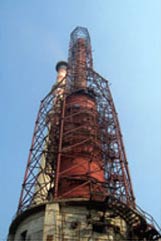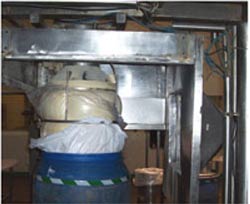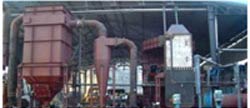- Aerosol Photometer
- HR-FMS Environment Monitorin...
- Airborne Particle Counters
- Biological Air Sampler
- Air Capture Hood and Anemome...
- Ozone Analyzer
- Differential Pressure Meter
- Temperature and Humidity Met...
- Dust Meter
- Measurement Meters
- GK-01 High Pressure Diffuser
- YWF-01 Fog Generator
- Gelbo Flex Tester System
-
other items
Indigenous Technology for Clean and Green Environmental Solutions
Indigenous Technology for Clean and Green Environmental Solutions
Problems of air pollution are getting severe day by day. Let it be particulate matter or gaseous pollutants such as SOx and NOx generated in textile, nylon, power generation, cement, food, steel, special chemical manufacturing; the amount of particulate matter, SOx and NOx in ambient air is restricted to 40-60 µg/m3, 20-50 µg/m3 and 30-40 µg/m3 respectively in India by law. (Ref. Gazette of India Nov 2009)
To achieve these figures, following sustainable Air Pollution Control Systems is need of the hour:
1. Flue Gas Desulphurisation Plants/ DeSOx of various designs
2. DeNOx/NOx reduction systems
3. Fume and Dust extraction systems
4. Bag Filters for product recovery or nuisance dust collection
5. Cyclones, super-efficient tangential entry Multiclones and Scrubbers
6. Solvent Recovery Systems
1. Flue Gas Desulphurisation Plants/DeSOx of Various Designs
The exhaust gases from several industrial processes like power generation, carbon black manufacturing, glass manufacturing, or any other process consuming high sulphur fuel emits sulphur dioxide (SO2) in large quantities. These emissions are harmful to environment in the form of corrosive atmosphere and acid rain as well as public health and shall be subject to stringent statutory norms in near future.
Removal of sulphur dioxide gases from industrial exhaust not only makes the plant green, but also generates valuable by-products like gypsum, Ammonium Sulphate, etc., which has sellable value.
Flue Gas Desulphurisation Plants are based on following technologies:
Wet Processes
• Limestone gypsum process
• Caustic based sodium bi-sulphite/sulphate process
• Duel alkali process
Semi-wet Processes
• Rapid absorption process
• Spray drying process
A Flue Gas Desulphurisation Plant (probably first of its kind in India) for a 45 MW captive power plant for a cement plant in North India is under commissioning.
This plant is designed on limestone based technology and will generate gypsum as by-product, which will be used for captive consumption in the same cement plant. This FGD plant shall replace the current practice of limestone injection in furnace resulting in
• Much improved SO2 absorption
• Effective use of limestone
• Generation of sellable by-products. (Limestone injection in furnace generates fly ash based material consisting of CaSO3 which has no sellable value and can be only land filled)
2. DeNOx/NOx Reduction Systems
 NOx air emissions have detrimental effects on health and environment. NOx denotes nitric oxide (NO) and nitrogen dioxide (NO2). NO converts to NO2 in the atmosphere in presence of light. Excessive amount of NO2 in air causes bronchitis and pneumonia. NO2 along with VOCs can cause eye irritation, crop damage and break down of rubber and plastics. It is also an acid rain precursor. Therefore DeNOx system is must.
NOx air emissions have detrimental effects on health and environment. NOx denotes nitric oxide (NO) and nitrogen dioxide (NO2). NO converts to NO2 in the atmosphere in presence of light. Excessive amount of NO2 in air causes bronchitis and pneumonia. NO2 along with VOCs can cause eye irritation, crop damage and break down of rubber and plastics. It is also an acid rain precursor. Therefore DeNOx system is must.
In addition, N2O, i.e., Nitrous Oxide produced in fossil fuel combustion has same effect that of CO2 (green house gas). Manmade NOx emissions are produced in power stations, IC engines, Industrial boilers, process heaters, combustion turbines, etc. There are two methods to reduce NOx in the atmosphere.
Selective Catalytic Reduction (SCR)
Selective Catalytic Reduction (SCR) is a means of converting nitrogen oxides, (also referred to as NOx) in the presence of a catalyst into dynamic nitrogen N2, and water.
A gaseous reducing agent, typically anhydrous ammonia, aqueous ammonia or urea, is added to a stream of flue or exhaust gas and is adsorbed on to a catalyst. Carbon dioxide, CO2 is a reaction product when urea is used as the reducing agent. The catalyst can be cleaned after certain number of cycles.
Selective Non-Catalytic Reduction (SNCR)
Selective Non-Catalytic Reduction (SNCR) is a post-combustion NOx control method that reduces NOx. As SNCR requires an elevated temperature, it is sometimes referred to as thermal reduction. The process is particularly applicable to older furnaces with longer residence times in the SNCR reaction temperature range, where combustion controls are very expensive or not possible, where the boiler has low capacity factor or having short remaining life. SNCR is a method to reduce nitrogen oxide emissions in conventional power plants that burn biomass, waste and coal.
The process involves injecting either ammonia or urea into the firebox of the boiler at a location where the flue gas is between 760 and 1,093°C (1,400 and 1,999.4°F) to react with the nitrogen oxides formed in the combustion process. The resulting product of the chemical reaction is elemental nitrogen (N2 ), carbon dioxide (CO2), and water (H2 O). This process is less frequently used due to high temperatures involved and lesser NOx reduction efficiency compared to SCR process.
Particulate, Fumes Collection And Removal Technolgies
3. Super Efficient Fume and Dust Extraction Systems
 Hazardous fumes are generated from open tanks, storage vessels, centrifuges, processing rooms, etc., in pharmaceutical as well as chemical industry. Similarly considerable amount of dust gets generated in every material handling application such as, belt conveyor transfer, feeding, screening, product storage and packaging area. Efficient fume and dust extraction systems are need of the hour for every industry not only to recover its valuable product but also to maintain clean environment in the industry premises.
Hazardous fumes are generated from open tanks, storage vessels, centrifuges, processing rooms, etc., in pharmaceutical as well as chemical industry. Similarly considerable amount of dust gets generated in every material handling application such as, belt conveyor transfer, feeding, screening, product storage and packaging area. Efficient fume and dust extraction systems are need of the hour for every industry not only to recover its valuable product but also to maintain clean environment in the industry premises.
Effective fume and dust extraction system is a must to collect hazardous fumes and dust to maintain clean environment. Fumes and dusty atmosphere is detrimental to the health of workmen. In order to meet the norms stipulated by ACGIH and OSHA, one has to design super efficient fume and dust extractors to suit the application.
The salient features of fume and dust extraction system are:
• The system should be strictly designed as per American Conference of Governmental Industrial Hygienists (ACGIH) standards and Occupational Safety and Hazards Administration (OSHA) Norms
• Fume and dust generation areas should be thoroughly studied for calculation of optimum air flow rate
• Customised solutions (Centralised or localised systems) must be offered depending on number of locations/points of the fume and dust generation areas
• Fume and dust properties should be studied before arriving at conveying velocities through ducts
• Appropriate systems should be designed on the basis of fume and dust capture velocity and dimensions of the dust generation areas
• Ducting routing along with branch connection of each suction point should be engineered for minimum pressure drop
• Each suction point should be provided with isolation valve/damper. This helps in regulation of air flow rate as well as isolation of that particular area from the entire system.
4. Bag Filters for Product Recovery or Nuisance Dust Collection
It is now proven that bag filters can be efficiently used to arrest any nature and amount of dust from any industrial process. Electrostatic precipitators are not very efficient when process conditions are fluctuating and emission requirement are stringent.
Salient features of a thoroughly engineered Co-Flow patented bag filter:
• Downward movement of dust laden gas from top substantially reduces the dust loading on filter bags and assists the dislodged dust to fall into the hopper.
• Dust laden gas enters through air entry bustle and gets distributed from all 4 sides. This avoids sudden impact on bags, which in turn increases the bag life.
• Reduced dust loading substantially improves the performance and reduces pressure drop thereby reducing the power consumption.
• Aluminium die cast venturi (min 4-5 mm thick) gives rigidity to the bag-cage-venturi assembly.
• Positive locking between bag and cage assembly with SS304 worm clamp for bag fixing. This avoids falling of bags during operation.
• Positive sealing arrangement between dirty and clean air plenum with forced clamping on top of each venture avoids possibility of leakage.

